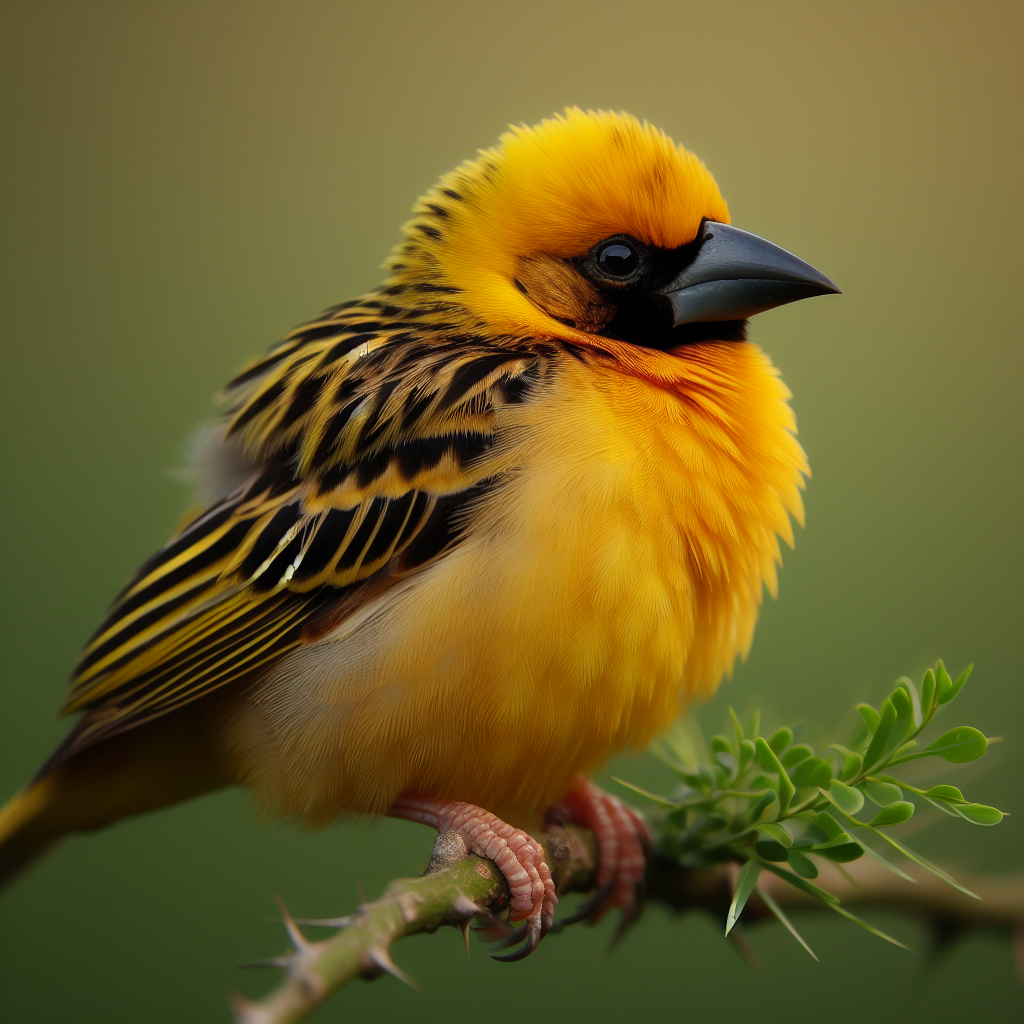Most beautiful small birds - Sykalo Eugen 2024
Southern Masked Weaver (Ploceus velatus)
Identification:
- Species name: Southern Masked Weaver, African Masked Weaver
- Scientific name: Ploceus velatus
- Family: Ploceidae (Weavers)
- Order: Passeriformes (Songbirds)
- Subclass: Neornithes (Modern birds)
- Class: Aves (Birds)
Description:
- Size: Medium-sized weaver, about 18-21 cm (7.1-8.3 in) long with a wingspan of 34-40 cm (13.4-15.7 in).
- Body shape: Compact and robust, with a strong, conical beak, a short, forked tail, and a distinctive mask.
- Plumage color:
Males: Vibrant crimson head, neck, and upper breast, contrasting with their black mask, streaked brown back, and pale underparts.
Females: Duller overall with less extensive red and more streaking throughout.
Strong, conical beak, black.
Sturdy, pink-brown legs.
Large, dark brown eyes.
Behavior:
- Method of feeding: Primarily eats seeds, grains, and fruits. May also take insects and other invertebrates. Forages on the ground, in vegetation, and at bird feeders.
- Reproduction: Builds elaborate woven nests, often suspended from trees or shrubs. Lays 2-4 pale pink eggs with dark speckles. Both parents care for the young.
- Movement: Resident in most of its range, with some local movements in response to food availability. May form large, noisy flocks outside of breeding season.
- Communication: Loud, whistling and chirping calls. Males have a complex song used to defend territory and attract mates.
Ecology:
- Habitat: Open savannas, grasslands, woodlands, and agricultural areas. Prefers areas with scattered trees and shrubs for nesting.
- Diet: Seeds, grains, fruits, insects, spiders, worms, and other small invertebrates.
- Hunting methods: Forages on the ground and in vegetation, picking up seeds and fruits. May glean insects from leaves and branches or catch them in flight.
Distribution: Found throughout southern Africa, from Angola and Namibia to South Africa and Mozambique.

The Southern Masked Weaver, a feathered architect and socialite painting the African savannas with flashes of black and gold! This resident of acacia trees might seem like a simple nest builder at first glance. But beneath its mask-like plumage and bustling colonies lies a treasure trove of surprising facts and adaptations that will transform this savanna engineer into a captivating master weaver, hidden feast master, and unexpected musical innovator in your eyes.
Masters of the Woven Wonderland: Forget twiggy platforms; Southern Masked Weavers reign supreme in the domain of sun-dappled branches and thorny acacia trees. Their powerful beaks and surprisingly nimble feet become architectural marvels, crafting intricately woven nests that hang like miniature fortresses from the branches. Imagine them as feathered Frank Lloyd Wrights with built-in miniature looms and an innate love for sky-high apartments.
Hidden Feasting Technique: Don't underestimate their dietary flexibility! While seeds are a staple, Southern Masked Weavers are opportunistic omnivores, readily adapting their menu to seasonal bounty. From juicy fruits and nectar to insects and even the occasional small reptile, their varied appetite keeps them fueled for energetic foraging sessions. Think of them as feathered savanna gourmands with built-in miniature buffets hidden within the thorny maze.
Singing with Rhythmic Spirit: Their calls aren't just chirps and whistles. Southern Masked Weavers possess a rich and distinctive repertoire, with clear, piping songs, intricate trills, and even a signature "chwee-chwee-chwee" duet call that echoes across the savanna. Their voices rise above the grasslands like feathered percussionists, drumming out rhythmic melodies and synchronized harmonies with captivating flair.
Unexpected Musical Innovators: They're not just vocal copycats. Southern Masked Weavers are known for their remarkable ability to incorporate the sounds of their environment into their songs, including rustling leaves, buzzing insects, and even the calls of other birds. This feathered maestro, with its built-in miniature soundboard and improvisational talents, becomes a captivating DJ of the savanna, remixing the soundscape with surprising creativity.
Champions of Community: They're not just solitary builders. Southern Masked Weavers live in large and bustling colonies, with hundreds of nests sometimes sharing a single acacia tree. This feathered city, with its constant chirping and bustling activity, becomes a haven of cooperation and social interaction.
Cultural Charmers: Across southern Africa, the Southern Masked Weaver has held diverse cultural significance. In some regions, its intricate nests are seen as symbols of craftsmanship and skill. In others, its large colonies inspire admiration for community and cooperation.
Unexpected Regional Variations: Did you know? Not all Southern Masked Weavers are the same! Different populations across their vast range show subtle variations in plumage color and call patterns, adding a touch of feathered diversity to this adaptable species.